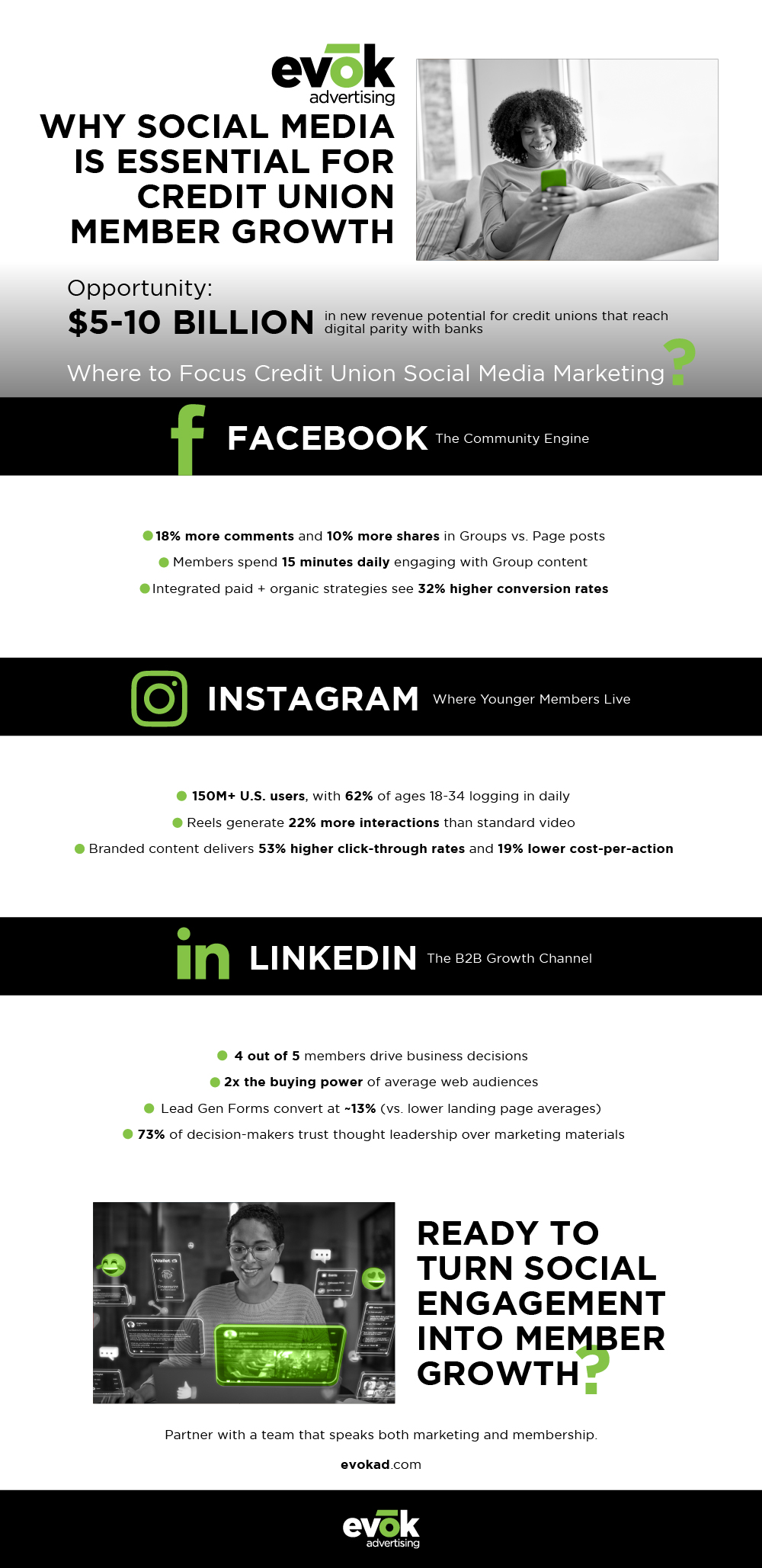
Credit Union Social Media Marketing: Building Communities That Drive Member Growth & Engagement
Why Social Media is Essential for Credit Union Member Growth and Community Building in 2026
Credit unions were built on connection — neighbors helping neighbors reach financial goals. That mission hasn’t changed, but how members connect with your institution has. In 2026, social media is set to become further solidified as the modern branch lobby: it’s where trust is earned, conversations happen, and members decide who feels most aligned with their values. For CMOs, that shift demands more than presence; it calls for a social media strategy for credit unions that treats social platforms as vital infrastructure for brand awareness, member engagement, and long-term growth.
What Is the Growth Opportunity for Credit Unions on Social Media?
The financial services landscape is evolving faster than most credit unions’ digital programs can keep up. According to McKinsey & Company, credit unions that reach parity with banks in digital sales could unlock $5 billion to $10 billion in new revenue, and social channels are a key driver of that growth. Yet the Financial Brand reports that digital onboarding abandonment rates still exceed 50% for deposit accounts and 75% for loans, suggesting that digital awareness and engagement pipelines remain under-optimized.
Younger audiences in particular are quick to disengage when those expectations aren’t met. Gen Z credit union members are twice as likely as average members to consider switching institutions — not for better rates, but for better digital experiences. Social media now plays a pivotal role in that experience, serving as both a discovery engine and a trust-builder. It’s where new members encounter your brand’s values, current members stay informed, and communities grow around shared goals.
For credit unions, this presents both an advantage and a challenge. The advantage lies in the authenticity that no fintech can replicate — community ties, real member stories, local impact. The challenge lies in matching that authenticity with a digital execution that reflects the same level of care and responsiveness. A seamless digital experience is now table stakes for member trust and retention.

Why 2026 Marks a Turning Point
Member demographics are shifting, competition is intensifying, and social platforms themselves are becoming more sophisticated. The coming year will favor credit unions that treat social media as a business driver, not a broadcast tool. Those who succeed will:
- Meet emerging generations where they already are. Millennials and Gen Z use social channels for everything from product research to peer recommendations, areas where credit unions can lead with financial education and real-member success stories.
- Transform engagement into measurable growth. Advanced targeting, community groups, and social commerce features turn social activity into tangible lead generation and conversion opportunities.
- Leverage data to personalize experiences. Every comment, click, and conversation provides behavioral insight that can inform future offers, refine audience segments, and increase share of wallet.
- Strengthen their community promise through visibility. By amplifying member voices and community impact, social becomes the digital expression of the credit union difference.
In short, the path forward isn’t just about gaining followers; it’s about building digital communities that mirror the trust and relationships credit unions were founded on. The following sections examine how each platform — including Facebook, Instagram, LinkedIn, and others — can help you fuel a measurable, compliant, and sustainable transformation on your own or with the support of a credit union social media marketing agency.
Facebook for Credit Unions: Creating Community Groups and Local Engagement Campaigns

While emerging platforms dominate headlines, Facebook remains unmatched for localized engagement, cross-generational reach, and conversion efficiency. For credit unions, it isn’t about keeping up with trends; it’s about owning the digital space where the community already lives. The most effective social strategies in 2026 will use Facebook not as a megaphone, but as an ecosystem—one that nurtures relationships, celebrates members, and translates engagement into measurable growth.
Facebook remains the backbone of local engagement for most credit unions, particularly as its audience skews toward Gen X and older Millennials—key segments for growth in deposits, mortgages, and auto loans. Despite ongoing shifts in the social landscape, it remains the most effective channel for community-driven storytelling and localized reach.
Leveraging Facebook Groups for Deeper Member Engagement
For credit unions, Facebook Groups can serve as an extension of the branch lobby, a place where members and prospective members engage, share, ask questions, and form connections around your institution’s mission. A well-designed Group might be titled “{Credit Union Name} Members & Community” or more narrowly, “{County} First-Time Homebuyers,” inviting current and potential members to join, ask questions, and learn together. When you moderate the Group actively—posting weekly prompts, running live Q&As with your local branch team, sharing member success stories, or featuring local business spotlights—you build a sense of belonging and achievement that strengthens member loyalty.
What makes this approach compelling is the level of engagement a Group can generate compared to a standard Page post. For example, data shows that Facebook Group posts can drive 18% more comments and 10% more shares than Page posts. Further still, Facebook reports that members of Groups spend meaningful time (on average, about 15 minutes daily) engaging with group content, a signal of deeper interest and sustained value.
Key execution points for credit unions:
- Define the Group’s purpose: It should support the brand’s mission (financial literacy, local business support, community wellness) rather than simply push products.
- Moderate thoughtfully: Encourage peer-to-peer interactions (members helping members) combined with staff-facilitated content (branch Q&As, finance tips).
- Leverage hyper-local content: Utilize geographic targeting to invite members within branch ZIP codes, host branch-event RSVP posts, and spotlight local community partnerships.
- Measure and refine: Use Facebook’s Group Insights to monitor growth, member activity, and trending posts (see how many actions per member per month).
Because trust and local connection matter more than ever in the credit-union space, a Facebook Group lets you build a digital community anchored in your institution’s values. Over time, members who engage in the Group are more likely to view your credit union as a trusted partner, and that predisposition helps when they’re ready to open an account, apply for a loan, or refer a friend.
How to Turn Facebook Engagement into Measurable Growth for Credit Unions
Even with substantial organic reach, growth depends on well-planned paid strategies. Facebook’s advanced audience tools enable credit unions to geotarget by ZIP code, branch radius, or even “people recently in this location,” making them ideal for promoting local events or new-member offers. Lookalike audiences built from member CRM data can expand that reach to prospects who closely resemble your existing community.
The key is integrating community storytelling and conversion-focused ads within the same ecosystem. For example:
- A community post celebrates a first-time homebuyer.
- That post is boosted locally with a “Learn More” CTA linking to a mortgage resource hub.
- Visitors who engage with the post are added to a retargeting audience for follow-up content, such as budget calculators, pre-approval forms, or educational videos.
This full-funnel structure aligns with broader credit union goals: converting engagement into account openings or loan applications. According to Hootsuite’s 2025 Social Trends Report, brands that integrate paid and organic social see up to 32% higher conversion rates than those managing them separately.
Instagram Strategy: Visual Storytelling with Member Spotlights and Financial Tips

Instagram remains one of the strongest brand-building tools for credit unions targeting Millennials and Gen Z — segments that now represent the largest share of potential new members. According to Statista, over 150 million U.S. users actively use Instagram, with roughly 62% of adults aged 18–34 logging in at least once daily. These users don’t just scroll for entertainment; they follow brands that reflect their values and provide lifestyle inspiration, including financial wellness.
For credit unions, Instagram is an opportunity to modernize brand perception while maintaining authenticity. Each post, story, and reel becomes part of a visual narrative that positions your institution as approachable, knowledgeable, and community-driven. A consistent, story-based approach transforms the feed from an advertising grid into a living portfolio of your members’ financial journeys.
Humanizing the Credit Union Brand Through Visual Storytelling
High-performing credit union accounts lean into storytelling — not stock imagery or product pushes. Real members, local businesses, and employees should take center stage. When people see familiar faces achieving financial goals, the message feels relatable and trustworthy.
A few proven formats:
- Member Spotlights: Capture real stories — a couple closing on their first home, a teacher opening a youth-savings account, or a small-business owner expanding with a credit union loan.
- Financial Tip Reels: Quick, digestible videos like “3 ways to boost your credit score” or “Budgeting tips before the holidays.”
- Behind-the-Scenes Stories: Showcase the people behind the institution — branch staff volunteering, preparing for events, or celebrating member milestones. This humanizes the organization and builds emotional connection.
To make the most of Instagram’s visual ecosystem:
- Use a consistent aesthetic (color palette, font, tone) that aligns with your brand but feels conversational and approachable.
- Maintain accessibility standards with closed captions and alt-text for all visual posts.
- Pair each piece with a clear call-to-action (Learn More, Join Now, Attend Our Workshop) linked via bio or story highlights.
Turning Creative Engagement Into Actionable Growth for Credit Unions
Credit union CMOs must connect moments of engagement on Instagram to measurable growth. Instagram’s native tools make this seamless when used strategically. CMOs can retarget users who’ve interacted with Reels or carousel posts by creating Custom Audiences and serving them ads that drive to lead forms or product applications. From there, Lookalike Audiences built from those engaged members can expand reach to similar prospects, increasing acquisition efficiency. Campaigns that combine branded storytelling with these data-driven tactics see markedly better performance—ads using branded content achieve 53% higher click-through rates and 19% lower cost-per-action than standard creative. This approach enables credit unions to utilize social engagement as a growth pipeline, leveraging awareness through authentic storytelling, retargeting through data-driven insights, and acquisition through optimized funnels. In this model, every view, save, and share becomes more than a metric—it becomes momentum toward measurable membership growth and product adoption.
For credit unions, Instagram’s value lies in its ability to bridge storytelling and measurable results. Engagement on the platform—particularly through Reels—has become a key driver of performance. Studies show Reels generate 22% more interactions than standard video posts, and brand accounts that consistently use the format outperform other video content types across social platforms. This increased engagement isn’t just vanity; it feeds Instagram’s algorithmic signals, helping your credit union’s content reach more potential members organically. By leading with authentic, visually compelling narratives—such as a first-time homebuyer success story or a staff member explaining auto loan benefits—you’re building trust through context, not through noise.
LinkedIn for Business Members: B2B Content and Commercial Services Marketing

LinkedIn’s core advantage for credit unions is the composition of its audience: the platform’s own marketing data reveals that 4 out of 5 members influence business decisions, and its audience has twice the purchasing power of the average web audience. That combination makes LinkedIn a high-signal environment to reach local owners, nonprofit leaders, and finance decision-makers for business checking, treasury, and commercial lending.
Credibility is the currency on LinkedIn, and thought leadership is one of the most effective ways to earn it. Seventy-three percent of decision-makers say an organization’s thought leadership is a more trustworthy basis for assessing its capabilities than its marketing materials or product sheets. That trust advantage is exactly what community-rooted credit unions can leverage by publishing practical insights on local cash-flow realities, financing options, and member business success stories.
Turning Thought Leadership Into Business Relationships
Treat executive-authored posts and company updates as your top-of-funnel engine, then connect engagement to lead capture using native tools. LinkedIn’s Lead Gen Forms reduce friction by auto-filling profile data; multiple benchmarks place their average conversion rate around 13%, materially higher than typical landing-page averages cited in B2B benchmarks. Use this format for mid-funnel assets like “Local Business Cash-Flow Checklist” or “Financing Your First Fleet Vehicle,” then sync leads to your CRM for banker follow-up.
For campaigns that require a broader reach with similar profiles, build Lookalike Audiences from your converters and recent engagers. LinkedIn provides direct controls for job function, seniority, company size, and geography, allowing your ads to concentrate on actual decision-makers within your field of membership. Pair those ads with executive posts that reinforce expertise (short POVs on regional trends, walk-throughs of loan scenarios), and measure what matters to the business: lead-form submissions and cost per qualified lead, plus closed-won business accounts or funded loans attributed via UTM parameters and CRM opportunity tracking.
To report impact at the board level, align metrics to commercial outcomes: engagement rate on leadership posts → Lead Gen Form conversions → % advancing to banker conversation → funded accounts/loans and subsequent cross-sell. Keep a running comparison of CPL/CPA from LinkedIn vs. other channels to guide budget. As a final accelerator, package the best-performing leadership posts into Sponsored Content and retarget engagers with the exact offer (e.g., “Book a consult with our Business Services team”).
The Takeaway
LinkedIn’s B2B environment rewards credibility, not clutter. For credit unions, this means success stems from consistent thought leadership, supported by data-driven advertising and internal advocacy. When your executives speak with authority, your content adds value, and your targeting connects to business decision-makers, LinkedIn becomes more than a networking site — it becomes your most powerful pipeline for commercial growth and long-term business membership.
Financial Literacy Social Media Content: Educational Posts That Build Trust and Establish Expertise

For a credit union, producing social media content that teaches rather than sells is a strategic advantage. Research shows that credit union members, on average, score higher in financial literacy assessments than non-member peers. By positioning your institution as a trusted educator (rather than just a product provider), you expand your role to include long-term member advocacy. In social terms, that means creating posts that address real, timely challenges, such as how to navigate first-time home buying, how to consolidate debt safely, and how to choose the right business credit card.
To execute this effectively, create a content framework where each post answers a straightforward member question, utilizes approachable visuals (such as infographics or short videos), and concludes with a low-bar action (e.g., downloading a checklist or joining a live Q&A). Promote across your social platforms and feed it into your email or digital banking nurture flows. Then track not just “views” or “likes,” but downstream metrics such as how many participants click into resource pages, schedule a consultation, or ultimately open a new account. This way, educational content becomes a direct contributor to acquisition and retention, not just feel-good content.
User-Generated Content and Member Testimonials: Authentic Social Proof That Converts

Authenticity drives trust in the social media space, and user-generated content (UGC), along with member testimonials, are among the most impactful formats. Data shows that UGC content earns up to 28% higher engagement rates than brand-produced content. Even more compelling: visitors who interact with UGC convert at over 100% higher rates than average. For credit unions, this means that a photo of a local member in front of their new home, or a short clip of a business-member talking about how your institution helped them expand, isn’t just nice-to-have—it’s a proven conversion lever.
To put this into practice, design campaigns that encourage members to share their stories: “Show us your first-time home purchase”, “Celebrate debt-free status with us”, “Our member-business: how they grew”. Obtain release permissions, provide simple templates or prompts, and amplify the best submissions via paid and organic posts. Then build a mini-funnel: UGC post → engagement (comments/shares) → download/checklist/application. By mapping this flow, you track UGC not just as content, but as a measurable driver of new-member or loan-application outcomes.
Nano and Micro-Influencer Partnerships: Working with Local Community Leaders

When national influencer budgets and reach don’t align with regional credit-union markets, nano (1k-10k followers) and micro (10k-50k followers) local personalities present a high-efficiency alternative. These community leaders—local entrepreneurs, nonprofit leaders, teachers, coaches—have built trust in your service area and can authentically amplify your message. In our own credit union marketing campaigns, we’ve found localized influencer content often delivers better engagement and cost efficiency than broad-reach campaigns. For example, niche influencer campaigns usually cost less and resonate more intimately.
For credit union influencer marketing, the approach is two-fold: identify local influencers whose values align with your mission (community service, local entrepreneurship, financial wellness); then co-create content that ties back to your services in a narrative form (e.g., “How I leveraged my credit-union business loan to grow my café”). Set clear KPIs: cost per lead from influencer link, number of new-member applications from that audience, and engagement uplift versus standard ads. Because micro-influencers are embedded in your region, their endorsement carries both reach and credibility, helping you convert “awareness” into “trusted consideration” and then to “application.”
Social Media Compliance for Credit Unions: NCUA Guidelines and Content Approval Workflows

For credit unions, striking a balance between creativity and compliance is a non-negotiable requirement. The NCUA’s advertising rule (§740.5) requires that every promotional message—digital or otherwise—clearly identify the institution as federally insured by the NCUA and include appropriate disclosures when referencing rates, loan terms, or deposit products. In practice, this means that every social post promoting a product must include standardized language (“Federally insured by NCUA”) and avoid making misleading statements about rates or approval likelihood. It also means all social interactions are subject to recordkeeping expectations under FFIEC guidance for electronic communications, which recommends maintaining accessible archives for potential audits.
Operationally, CMOs should implement a two-tier review process: (1) marketing reviews for brand accuracy and tone, followed by (2) compliance sign-off for required disclosures and adherence to NCUA advertising standards. Modern social-media-management tools such as Hootsuite, Sprout Social, and Social Assurance offer workflow controls that enforce this sequence and preserve immutable archives for every approved post. By structuring compliance into your publishing workflow rather than treating it as a bottleneck, your teams maintain agility while meeting regulatory expectations.
Creating a Social Media Content Calendar: Balancing Education, Engagement, and Promotion

An effective credit union social calendar balances three key content pillars: education, engagement, and promotion. Based on our experience as a credit union social media marketing agency, we’ve found a good ratio for content to be about 60% educational, 20% community/engagement, and 20% promotional content monthly. This mix reflects the reality that members engage more with relatable, helpful information than with product offers alone. By mapping these content types across a 30- or 90-day calendar—anchored to campaign cycles, seasonal milestones, and local events—you create predictability and purpose in your posting cadence.
Automation is key. Scheduling platforms like HeyOrca or Sprout Social allow CMOs to view post performance in aggregate and quickly reallocate emphasis between channels or topics. Quarterly audits should evaluate which content drives conversions (e.g., account openings, loan leads) and which drives top-of-funnel awareness (e.g., community or educational posts). Over time, this data builds a feedback loop, helping the marketing team fine-tune the ratio of “member value” content to “institution value” content—ensuring your calendar is not just consistent but strategically aligned with growth goals.
Measuring Social Media ROI: Tracking Member Acquisition, Engagement, and Conversion Rates

To prove social media ROI at a credit union, connect platform metrics to business outcomes you can take to the board: leads, funded accounts/loans, and retained relationships. Start by benchmarking engagement against your peers to determine whether the content is competitive. Current public benchmarks show financial services engagement typically sits in the low single digits (e.g., Hootsuite’s 2025 sector update lists ~1.8% on Facebook and ~3.8% on Instagram), which helps you separate underperforming content from a tough category baseline. Rival IQ’s 2025 industry report also documents a broad year-over-year decline in engagement across networks—useful context when trendlines dip even as your program improves elsewhere. Together, these sources give you a realistic “floor” before you attribute growth to channel strategy.
From there, attribute outcomes with clean plumbing: UTM parameters on every link, CRM integrations to track social-sourced members through the application and funding process, and paid funnels that minimize drop-off. On LinkedIn, for example, native Lead Gen Forms consistently convert above typical landing-page averages, which can materially lower CPL for commercial or business-banking offers—especially when paired with executive thought leadership and precise targeting. Reporting should roll up by campaign: engagement rate → lead-form submits → banker conversations → funded accounts/loans → cross-sell and retention for the social-acquired cohort. Present both efficiency (CPL/CPA vs. other channels) and quality (share of wallet, retention) to show social’s full financial impact.
Tools and Platforms: Social Media Management Software for Credit Unions

Selecting the right tech stack ensures both compliance and efficiency. Credit unions benefit from platforms that combine publishing, monitoring, analytics, and archiving in one environment. Tools such as Sprout Social, Hootsuite, and Social Assurance are widely used in financial services for their multi-level approval workflows, FINRA/FFIEC-compliant archiving, and performance dashboards. Integration with CRMs like Salesforce Financial Services Cloud or Alkami’s marketing suite enables attribution, linking social engagements directly to member journeys and lending pipelines.
When evaluating vendors, CMOs should prioritize permission controls (branch-level vs. corporate posting rights), customizable disclosure templates, and real-time reporting dashboards. The most advanced setups layer AI-based sentiment analysis and geo-tag tracking to gauge member sentiment by region or branch footprint. The right platform provides the operational visibility and governance credit unions need to prove ROI and protect brand reputation at scale.
How Credit Union Marketing Agencies Build Social Media Programs That Drive Member Growth

Most credit unions face a common challenge: their marketing teams understand financial products deeply but lack the dedicated bandwidth to execute sophisticated, multi-platform social strategies while maintaining compliance rigor. The gap between “we should be doing more on social” and “we’re systematically converting social engagement into funded accounts” often comes down to specialized expertise and operational infrastructure that doesn’t exist in-house.
This is where a credit union-focused marketing agency becomes a strategic partner rather than a vendor. The right agency brings three critical capabilities that internal teams rarely have time to build: deep domain knowledge of credit union member behavior and regulatory requirements, platform-specific technical expertise that keeps pace with algorithm changes and new ad formats, and the data infrastructure to connect social activity directly to member acquisition and loan pipelines.
The execution model starts with strategic alignment, not creative brainstorming. Before a single post is drafted, the agency should map your institution’s growth priorities—whether that’s increasing share of wallet among existing members, penetrating a new geographic market, or launching a commercial lending practice—to specific social objectives and KPIs. From there, the work becomes systematic: social listening identifies the questions or concerns your target members may already be discussing online, competitive analysis reveals content gaps your credit union can own, and audience segmentation ensures every dollar of paid spend reaches prospects with genuine intent and qualification.
What separates high-performing programs from mediocre ones is the integration layer. Content calendars should be built around member lifecycles, not arbitrary posting schedules. Paid campaigns should retarget users based on their engagement signals, not just demographics. Creative should ladder from awareness (educational reels, member stories) to consideration (product explainers, comparison content) to conversion (rate promotions, application CTAs). And crucially, every campaign asset must move through a compliance review workflow that’s embedded in the publishing platform itself, ensuring regulatory requirements never become bottlenecks.
At evok advertising, we’ve engineered our process specifically for this reality. Our team has partnered with credit unions for decades, translating business objectives into digital programs that deliver measurable membership growth, increased loan originations, and deeper engagement across the member base. We combine strategic planning, compliant creative execution, advanced paid media management, and closed-loop analytics into one integrated system. That means your social performance is tracked not just in engagement rates, but in member acquisition cost, loan conversion rates, and long-term relationship value—the metrics that matter to your board and your bottom line.
The credit unions seeing the strongest results today aren’t the ones with the biggest budgets or the most flashy content. They’re the ones treating social media as essential member infrastructure, supported by partners who understand that every post, ad, and interaction is an opportunity to reinforce trust and drive tangible growth. Suppose your institution is ready to move beyond social presence and build a program that systematically converts community engagement into member relationships. In that case, we should discuss what that transformation entails for your credit union.